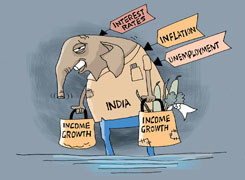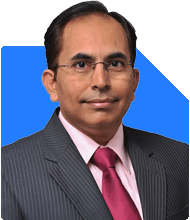Ramalingam Kalirajan |9309 Answers |Ask -Follow
Mutual Funds, Financial Planning Expert - Answered on Jun 04, 2025
He has an MBA in finance from the University of Madras and is a certified financial planner.
He is the director and chief financial planner at Holistic Investment, a Chennai-based firm that offers financial planning and wealth management advice.... more

Hi Sir, I'm earning 1.75 lacs per month after deduction and yearly bonus of 3-4 lacs. I have a personal loan and recently started due to an emergency - paid 5 EMI's already and it's for 5 years - emi is 55k per month and rate is 10.9% - I recently started 10k per month SIP, good thing is that I bought 3 plots recently, bought a gold of 3.5 lacs last year and I don't need to pay any emi for it. Do suggest your thoughts. Btw I'm 29 and not married.
1. Income and Loan Commitments
Net Monthly Income: Rs. 1.75 lakhs
Personal Loan EMI: Rs. 55,000 (for 5 years at 10.9% interest)
Remaining Monthly Income: Rs. 1.20 lakhs
Your EMI constitutes approximately 31% of your net income, which is within manageable limits. However, considering the high-interest rate, it's prudent to strategize for early repayment to reduce interest outgo.
2. Investment Portfolio
Mutual Fund SIP: Rs. 10,000 per month
Gold Investment: Rs. 3.5 lakhs (acquired last year)
Real Estate: 3 plots (no EMI obligations)
Your current investment approach demonstrates foresight. Diversifying into mutual funds and gold provides a balanced risk profile. However, it's essential to ensure that your investments align with your financial goals and liquidity needs.
3. Emergency Fund
An emergency fund is crucial to cover unforeseen expenses and avoid financial strain. Aim to accumulate 6 months' worth of expenses in a liquid and accessible form. This fund acts as a financial cushion during unexpected events.
4. Insurance Coverage
Adequate insurance coverage is vital to protect against unforeseen circumstances. Ensure you have:
Health Insurance: To cover medical emergencies
Term Life Insurance: To secure your family's financial future.
Regularly review and update your insurance policies to match your current lifestyle and obligations.
5. Financial Goals and Planning
Setting clear financial goals helps in creating a roadmap for your investments. Consider the following:
Short-Term Goals: Emergency fund, vacation, gadgets
Medium-Term Goals: Buying a car, higher education.
Long-Term Goals: Retirement planning, children's education.
Align your investments to meet these goals effectively.
6. Investment Strategy
Your current SIP of Rs. 10,000 is a good start. Consider increasing it gradually as your income grows. Diversify your mutual fund investments across different categories to balance risk and returns. Actively managed funds, guided by a Certified Financial Planner, can help in achieving better returns compared to index funds.
7. Real Estate Investments
Owning three plots is a significant investment. However, real estate is an illiquid asset and may not provide immediate returns. Ensure that this investment aligns with your long-term financial goals and doesn't hinder your liquidity needs.
8. Gold Investment
Gold serves as a hedge against inflation and adds diversification to your portfolio. Monitor gold prices and market trends to make informed decisions about holding or liquidating this asset.
9. Tax Planning
Efficient tax planning can enhance your savings. Utilize available deductions under sections like 80C, 80D, etc., to minimize tax liability. Investments in PPF, ELSS, and health insurance premiums can aid in tax savings.
10. Regular Financial Review
Conduct periodic reviews of your financial portfolio to assess performance and make necessary adjustments. Life events and market dynamics can influence your financial needs, making regular reviews essential.
Final Insights
Your proactive approach to financial planning at a young age is commendable. By focusing on debt reduction, strategic investments, and regular financial reviews, you can build a robust financial foundation. Engaging with a Certified Financial Planner can provide personalized guidance tailored to your financial goals.
Best Regards,
K. Ramalingam, MBA, CFP,
Chief Financial Planner,
www.holisticinvestment.in
https://www.youtube.com/@HolisticInvestment
You may like to see similar questions and answers below
Ramalingam Kalirajan |9309 Answers |Ask -Follow
Mutual Funds, Financial Planning Expert - Answered on May 23, 2024
Ramalingam Kalirajan |9309 Answers |Ask -Follow
Mutual Funds, Financial Planning Expert - Answered on Jun 25, 2024
Janak Patel |53 Answers |Ask -Follow
MF, PF Expert - Answered on May 20, 2025
Ramalingam Kalirajan |9309 Answers |Ask -Follow
Mutual Funds, Financial Planning Expert - Answered on Jun 21, 2025
Nayagam P P |7713 Answers |Ask -Follow
Career Counsellor - Answered on Jul 03, 2025
Nayagam P P |7713 Answers |Ask -Follow
Career Counsellor - Answered on Jul 03, 2025
Nayagam P P |7713 Answers |Ask -Follow
Career Counsellor - Answered on Jul 03, 2025
Nayagam P P |7713 Answers |Ask -Follow
Career Counsellor - Answered on Jul 03, 2025
Nayagam P P |7713 Answers |Ask -Follow
Career Counsellor - Answered on Jul 03, 2025
Nayagam P P |7713 Answers |Ask -Follow
Career Counsellor - Answered on Jul 03, 2025
Nayagam P P |7713 Answers |Ask -Follow
Career Counsellor - Answered on Jul 03, 2025
Shalini Singh |165 Answers |Ask -Follow
Dating Coach - Answered on Jul 03, 2025
Dr Dipankar Dutta |1681 Answers |Ask -Follow
Tech Careers and Skill Development Expert - Answered on Jul 03, 2025
Dr Dipankar Dutta |1681 Answers |Ask -Follow
Tech Careers and Skill Development Expert - Answered on Jul 03, 2025




















